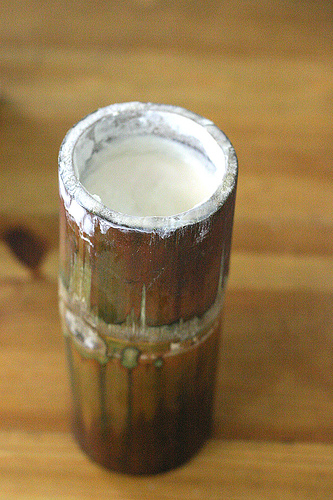Dadiah


Dadih (Indonesian: Dadih), a traditional fermented milk of West Sumatra, Indonesia, is made by pouring fresh raw unheated buffalo milk into a bamboo tube capped with a banana leaf, and allow to ferment spontaneously at room temperature for two days.
The milk is fermented by indigenous lactic bacteria of the buffalo milk. Its natural fermentation provides different strains of indigenous lactic bacteria involved in each fermentation[1]. The natural indigenous lactic acid bacteria observed in dadih could be derived from bamboo tubes, buffalo milk or banana leaves involved in milk fermentation.
Dadih is usually eaten for breakfast, mixed together with ampiang (traditional glutinous rice krispies) and palm sugar. Dadih can also be eaten with hot rice and sambal.
Some studies on probiotic properties of indigenous strains isolated from dadih fermented milk demonstrated to exhibit antimutagenic, acid, and bile tolerance as well as antipathogenic properties[2][3]. Natural wild strains isolated from dadih show inhibitory, competitive and displacing properties against pathogens, and they are promising candidates for future probiotics[4]. Viable cells of Lactobacillus plantarum strains from dadih as well as active metabolism play important roles in removing microcystin-LR, cyanobacterial toxin, and natural wild strain of Lactobacillus plantarum from dadih has the highest removal abilities as compared to the other commercial probiotic strains. This finding offers new and economical tools for decontaminating microcystin containing water[5][6].
References
- ^ Akuzawa R, Surono IS. 2002. Fermented milks of Asia. In: Encyclopaedia of dairy science. London: Academic Press. p 1045–1048
- ^ Surono IS, Hosono A. 1996. Antimutagenicity of milk cultured with lactic acid bacteria from dadih against mutagenic terasi.Milchwissenschaft 51:493–497
- ^ Surono IS. 2003. In vitro probiotic properties of indigenous dadih lactic acid bacteria. Asian-Aus J Anim Sci 16:726–31
- ^ Collado, M. Carmen, Ingrid Surono, Jussi Meriluoto and Seppo Salminen. Potential probiotic characteristics of Lactobacillus and Enterococcus strains isolated from traditional dadih fermented milk against pathogen intestinal colonization. Journal of Food Protection, March 2007 (Journal of Food Protection, Vol. 70, No. 3, 2007, 700–705)
- ^ Surono IS, M. C. Collado, Seppo Salminen and Jussi Meriluoto. Effect of glucose and incubation temperature on metabolically active Lactobacillus plantarum from dadih in removing microcystin-LR (Food and Chemical Toxicology Volume 46, Issue 2, February 2008, Pages 502-507)
- ^ Nybom, Sonja M. K., M. Carmen Collado, Ingrid S. Surono, Seppo J. Salminen, and Jussi A. O. Meriluoto. Effect of glucose in removal of microcystin-LR by viable commercial probiotic strains and strains isolated from dadih fermented milk. (Journal of Agriculture and Food Chemistry, Vol 56, No 10, 2008)
Online articles
- Article in Kompas (id)
- Another article in Kompas (id)
- Article on the Minangkabau forum Cimbuak (id)
- Article by Surono (id)